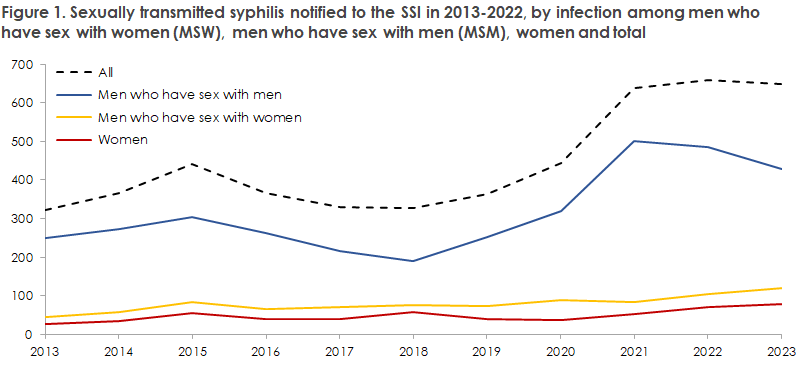No 42/43 - 2024
Syphilis 2023
Syphilis 2023
- In 2023, 649 cases of syphilis were reported to Statens Serum Institut (SSI), of which 66% occurred among men who have sex with men (MSM).
- The increase in syphilis cases among MSM from 2019 to 2022 was replaced by a slight decline in 2023, while a small increase was observed in heterosexual transmission (30% in 2023, up from 27% in 2022).
- The vast majority of syphilis cases, in both men and women, were acquired in Denmark (88%); the most common countries of infection thereafter were Germany, Thailand, Spain, and the USA.
- HIV status information was available for 86% of the syphilis cases reported in 2023. A total of 110 of those reported also had HIV. The majority were already known to have HIV, though six MSM and one trans woman were reported as newly diagnosed.
- Syphilis, as in 2022, was most common among those aged 30-49; the median age was 41 years for men and 37 years for women.
- In 2023, ten women were confirmed to have syphilis in prenatal screening, of whom two were not reported. Of the eight who were reported, six were born in Denmark.
- No cases of congenital syphilis were reported in 2023.
- Frequent testing in relevant groups can help break chains of transmission and thus contribute to a reduction in the number of syphilis cases.
In 2023, 649 cases of syphilis were reported to the Department of Infectious Disease Epidemiology and Prevention, Statens Serum Institut, Figure 1. The 649 cases were distributed among 638 individuals, as 11 individuals were reported with more than one case during the year.
Read a more detailed description of the incidence in 2023 in the annual report on syphilis 2023.

As in 2022, there is a small but concerning rise among heterosexuals, indicating that syphilis is establishing itself within the general population. It is therefore important for physicians to remember to consider syphilis as a possible differential diagnosis, including among heterosexuals. Additionally, it is essential to maintain prenatal screening in Denmark to prevent an increase in congenital syphilis cases. Among the 78 reported cases of syphilis found in women in 2023, eight (10%) were identified among pregnant women, six of whom were born in Denmark. Another two cases of syphilis in pregnant women were detected through prenatal screening. In 2023, no cases of congenital syphilis were reported.
In 110 cases, the patient reported with syphilis also had HIV; 103 were previously known cases of HIV, and seven were newly diagnosed. Six of these seven were MSM, while one newly diagnosed HIV case was in a trans woman. There is already significant focus on HIV testing among MSM with sexually transmitted infections, including syphilis. However, it is also important to remember to test for HIV if relevant exposure has occurred, including among heterosexuals, transgender individuals, and especially sex workers.
Among the 451 HIV-negative syphilis cases, 119 were reported to be on PrEP (Preexposure Prophylaxis, i.e., medication taken preventatively against HIV), with the majority being MSM.
According to the Danish Executive Order on the Notification of Infectious Diseases (BEK 1260 of 27/10/2023), all stages of syphilis must now be reported electronically via the Health Data Agency’s Electronic Reporting System, SEI2.
(L.H. Holm, S. Voss, S. Cowan, M. Wessman, Department of Infectious Disease Epidemiology and Prevention)
October 23, 2024